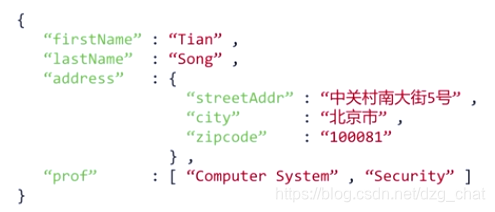有部分内容为北理嵩天老师的爬虫教程的个人学习笔记,结合其他博客整理学习。
前言:信息标记形式
html是将声音、图像、音频嵌入到文本中,是Internet上的主要信息组织、传递形式,通过预定义的标签< >…</ >将不同类型的信息组织起来。国际上标准的信息标记形式有XML JSON YAML 三种。
XML 扩展标记语言
标签形式类似html,应用在Internet主流信息交互和传递。
有内容有一对儿标签加内容属性< name>…< /name>,无内容直接省略用一对肩括号表示< name />。可加注释。
实例:
< title>标题名< /title>
< body>数值为多少< /body>
JSON
JavaScript面向对象属性。用在程序对接口处理的地方,经过传输后作为代码的一部分,并被程序直接运行,才可以发挥它数据类型的意义和优势。
属于有数据类型的键(key)值(value)对。
“name”:“王老五”
一个键可能对应多个值,用 [ ] 表示
“name” : [“王老五”,“王老六”]
键值对可以嵌套使用。把键值对放进新键值对的值部分,用 { } 表示。
“key” : { “zikey” : [ “w” , “z”] }
采用有类型的键值对,里面的值是数字类型时就不用加 " " 符号
实例:
YAML
无 ‘’ ‘’ 引号的键值对形式,一般用在系统配置文件,有注释,简单易读。
用 缩进 表示 所属关系
name :
value
key:
zikey : value
用 - 减号表示 value 值的并列关系。
用 # 表示注释
name: #comment
-王老五
-王老六
提取网页中信息标记的几种方式
1、完全解析标记形式,再去按标记提取关键信息。(准确、繁琐、速度慢)
2、无视标记形式,直接进行搜索。(过程简单,快、提取结果准确性不好)
3、两种方法结合。
实例:寻找一个页面内包含的所有url链接。
#BS4openfile.py
from bs4 import BeautifulSoup
html = '''
<html><head><title>This is a python demo page</title></head>
<body>
<p class="title"><b>The demo python introduces several python courses.</b></p>
<p class="course">Python is a wonderful general-purpose programming language. You can learn Python from novice to professional by tracking the following courses:
<a href="http://www.icourse163.org/course/BIT-268001" class="py1" id="link1">Basic Python</a> and <a href="http://www.icourse163.org/course/BIT-1001870001" class="py2" id="link2">Advanced Python</a>.</p>
</body></html>
'''
soup = BeautifulSoup(html,"html.parser")
for link in soup.find_all('a'):
print(link.get('href'))
>>>
http://www.icourse163.org/course/BIT-268001
http://www.icourse163.org/course/BIT-1001870001
1、安装
该第三方库可以对html 和 xml 页面进行解析,提取相关信息。
管理员权限启动cmd命令,使用pip 安装BeautifulSoup4
pip install BeautifulSoup4
获取一个html页面,并对它进行beautifulsoup解析。
import requests
from bs4 import BeautifulSoup
#调用时将BeautifulSoup4库缩写为bs4进行调用,若为pycharm环境需要再安装一下bs4包
r = requests.get("http://python123.io/ws/demo.html")
print(r.text)
demo = r.text
soup = BeautifulSoup(demo, "html.parser") #后面参数为解释器类型,需要其他时需单独安装
#soup = BeautifulSoup(open("文件.html"), "html.parser") #打开保存在本地的html文件形式
print(soup.prettify()) #prettify()方法为文本内容增加换行符,属于一种格式化的输出方法
其他解析器:
2、基本元素
html文件中的内容由肩括号和具体的标签以及标签属性构成,属性由键值对表示。
BS4库的基本元素:
以一段html代码为例,我们打开上面出现的网址:https://python123.io/ws/demo.html ,右键查看源代码:
<html><head><title>This is a python demo page</title></head>
<body>
<p class="title"><b>The demo python introduces several python courses.</b></p>
<p class="course">Python is a wonderful general-purpose programming language. You can learn Python from novice to professional by tracking the following courses:
<a href="http://www.icourse163.org/course/BIT-268001" class="py1" id="link1">Basic Python</a> and <a href="http://www.icourse163.org/course/BIT-1001870001" class="py2" id="link2">Advanced Python</a>.</p>
</body></html>
2.1 Tag标签
以指定的解析器打开上面的网页源代码:
#BS4openfile.py
from bs4 import BeautifulSoup
html = '''
那段源代码
'''
soup = BeautifulSoup(html,"html.parser")
print(soup.prettify()) #格式化输出
输出显示:
========== RESTART: D:/MathElectric/python/BS4openhtml.py ===============
<html>
<head>
<title>
This is a python demo page
</title>
</head>
<body>
<p class="title">
<b>
The demo python introduces several python courses.
</b>
</p>
<p class="course">
Python is a wonderful general-purpose programming language. You can learn Python from novice to professional by tracking the following courses:
<a class="py1" href="http://www.icourse163.org/course/BIT-268001" id="link1">
Basic Python
</a>
and
<a class="py2" href="http://www.icourse163.org/course/BIT-1001870001" id="link2">
Advanced Python
</a>
.
</p>
</body>
</html>
>>>
这里面 < html>… < /html>、< body>…< /body>、< p>…< /p>、< a>…< /a>都是标签。
2.2 标签名
打印显示html的指定标签时:
print(soup.title) ##显示全部标签
>>> <title>This is a python demo page</title>
print(soup.tag)
print(soup.tag.name) #只获取标签名
print(soup.title.name)
>>> title
标签存在一级一级包含关系,如title标签就在head标签内,head标签就是title标签的父标签。获取某标签的父标签及其父标签的名字:
print(soup.title.parent)
>>>
<head><title>This is a python demo page</title></head> #注意显示的是整个标签全部
print(soup.title.parent.name) #仅显示标签名
>>>
head
2.3 标签属性
标签的属性:
print(soup.p.attrs) #返回一个 字典 包含所有属性
>>>
{'class': ['title']}
print(soup.p.attrs['class']) #也可以单独取某个属性,还可以对属性进行修改、删除
>>>
['title']
soup.p.attrs['class'] = "NewClass"
2.4 标签内容string
标签的string 属性:NavigableString , 显示标签的内容
print(soup.title.string) #显示标签的具体内容
>>>
This is a python demo page
2.5 标签的注释
标签的comment注释:
from bs4 import BeautifulSoup
newsoup = BeautifulSoup("<b><!--This is a comment--></b><p>This is not a comment</p>", "html.parser")
newsoup.b.string
》
'This is a comment'
newsoup.p.string
》
'This is not a comment'
type(newsoup.b.string)
》
<class 'bs4.element.Comment'>
type(newsoup.p.string)
》
<class 'bs4.element.NavigableString'>
两种不同类型的标签在打印的时候并没有标注说明,去掉了注释的 !---- 符号,但是字段的数据类型是不同的,需要注意。
3、HTML 的信息遍历
这是一种树形结构的文本信息。
3.1、上行遍历
parent 属性和 parents 属性
parent 是当前节点的父标签,parents 是所有的父辈们的标签。
打印parent是输出标签,parents是一个需要遍历输出的类
遍历 p 标签的父辈们,并显示标签名:
for parent in soup.p.parents:
if parent is None:
print(parent)
else:
print(parent.name)
>>>
body
html
[document]
html 是顶级标签,父标签为自己,soup 的先辈不存在.name信息
3.2、下行遍历
contents 属性
子节点的列表,将标签的所有 子 节点存入 列表。包含换行符等。
print(soup.body.contents)
>>>
['\n', <p class="title"><b>The demo python introduces several python courses.</b></p>, '\n', <p class="course">Python is a wonderful general-purpose programming language. You can learn Python from novice to professional by tracking the following courses:
<a class="py1" href="http://www.icourse163.org/course/BIT-268001" id="link1">Basic Python</a> and <a class="py2" href="http://www.icourse163.org/course/BIT-1001870001" id="link2">Advanced Python</a>.</p>, '\n']
print(len(soup.body.contents)) #获取子节点的数量
>>>
5
因为是列表类型,所以列表的常规操作可以使用。
children 属性。
子节点的遍历操作:因为对象不是一个列表,所以不能直接打印输出。
for child in soup.body.children:
print(child)
print("**")
print("===================")
descendants 属性
所有的子孙节点进行遍历,和contents与children不同的地方在于上面两个属性只是与body直接相关的,而descendants是所有的子孙节点都包含。
for desc in soup.body.descendants:
print(desc)
print("*****")
3.3、平行遍历
平行遍历的前提是所有的节点在同一个父亲节点之下,否则不能构成平行遍历关系。
next_sibling 属性
返回按照html文本顺序的下一个平行节点(标签)
print(soup.a.next_sibling)
print(soup.a.next_sibling.next_sibling)
>>>
and
<a class="py2" href="http://www.icourse163.org/course/BIT-1001870001" id="link2">Advanced Python</a>
previous_sibling 属性
上一个节点。
next_siblings 属性
迭代类型,需遍历,按照文本顺序后续的所有。
previous_siblings 属性
迭代类型,所有前续的平行节点。
4、基于BS4库的常用Html内容查找方法
在soup变量中查找相关信息,
通常将<标签>.find__all(…)简写为<标签>(…)
将soup.find_all(…)简写为 soup(…)
4.1、典型方法详细介绍
<>.find_all(name,attrs,recursive,string,**kwargs)
4.1.1 name参数
根据标签名称检索相应字符串,返回包含被检索标签的所有标签列表
print(soup.find_all('a'))
》》
[<a class="py1" href="http://www.icourse163.org/course/BIT-268001" id="link1">Basic Python</a>, <a class="py2" href="http://www.icourse163.org/course/BIT-1001870001" id="link2">Advanced Python</a>]
也可以同时查找显示多种标签 a 和 b 及c :
soup.find_all(['a','b','c'])
当 name 参数为True 时,显示soup所有标签的信息。
for tag in soup.find_all(True):
print(tag.name)
》》
html
head
title
body
p
b
p
a
a
结合正则表达式(Re)库只查找显示包含某个字母或单次的所有标签
import re
soup.find_all(re.compile(‘b’))
只查找和 b 相关的,输出为b 和 body的标签信息。
4.1.2、attrs
表示对标签的属性进行字符串检索,可以查看带有某个属性的标签。
soup.find_all('p','course')
#查找返回 p 标签内的包含 course 属性信息的标签
查找确定的内容信息:注意输入时不使用精确查找会匹配不到
print(soup.find_all(id='link1')) #精确
print('*****')
print(soup.find_all(id='link')) #不精确
》》
[<a class="py1" href="http://www.icourse163.org/course/BIT-268001" id="link1">Basic Python</a>]
*****#上、下为精确和不精确匹配的输出
[]
想不精确,查找带某个关键词的时候使用正则表达式
soup.find_all(id=re.compile('link'))
》》
******
[<a class="py1" href="http://www.icourse163.org/course/BIT-268001" id="link1">Basic Python</a>, <a class="py2" href="http://www.icourse163.org/course/BIT-1001870001" id="link2">Advanced Python</a>]
4.1.3 recursive
表示是否对子孙全部节点检索,默认为True,若只对当前节点的 子节点搜索,则更改为False
对比一下两种表达式的输出差别:
soup.find_all('a') #全部子孙节点
soup.find_all('a',recursive=False) #只对子节点
》》
[<a class="py1" href="http://www.icourse163.org/course/BIT-268001" id="link1">Basic Python</a>, <a class="py2" href="http://www.icourse163.org/course/BIT-1001870001" id="link2">Advanced Python</a>]
[]
4.1.4、 string
对标签中间的字符串域<>…<>进行检索,检索时精确输入,不精确输入时使用正则表达式。
print(soup.find_all(string = re.compile('pyth'))) #正则模糊检索,返回猎豹
》》
['This is a python demo page', 'The demo python introduces several python courses.']
4.2 其他常用方法
参数属性和find_all() 一致。
注意使用的时候是和标签相关的。
使用时应该是具体的哪个标签,再去找它的子孙辈或者先辈:
print(soup.a.find_parent('p'))
print('****')
print(soup.a.find_parents('p'))
如果直接是soup.find:
print(soup.find_parent('a'))
因为soup是顶级,可能返回的都是NONE 或者空 [ ]







